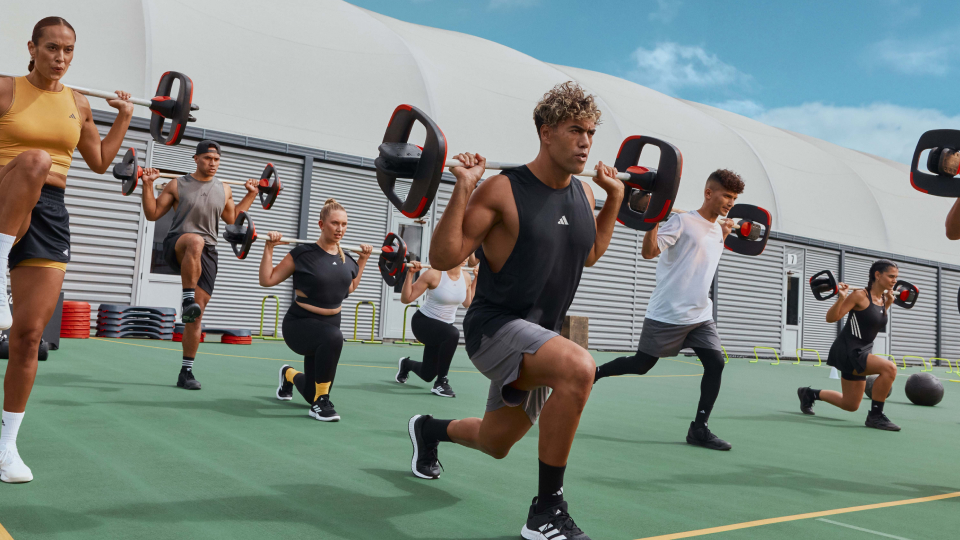The longevity movement
Forget the quick and fast fitness fixes, exhausting workout challenges, new exercise fads and unsustainable routines. In 2025 we can expect to see a focus on more sustainable exercise efforts – thanks to the increasing realization that there is no such thing as a quick win when it comes to health and fitness! Making a shift towards exercise that is sustainable means choosing workouts that you enjoy for the long term, and that drive long-term benefits.
With this in mind, the popularity of strength training will likely continue to surge as people tap into the life-lengthening benefits that come from building muscular fitness. In addition to traditional lifting, we can expect to see more functional training – with movements that translate to everyday activities coming to the fore. And low-impact exercise is also set to take off. Low-impact exercises put no added stress on your joints, and many low-impact workouts can be great for improving mobility and assisting ongoing injury prevention. Best of all, most low-impact exercises can be done at varied paces, which makes them suitable for all fitness levels.

Genetic intelligence
We know that our genetic makeup plays a fundamental role in shaping our strength, fitness and health, but that's just the tip of the iceberg. With genomic technology and intelligence advancing at speed, experts are rapidly unlocking new learnings about human biology. This is good news for anyone interested in a more personalized and tech-driven approach to health and wellness. Genomic testing is set to become more accessible, with specialist providers being able to identify the power of different genetic variations and offer tailored exercise and nutrition guidance based on your personal genetic profile.

Cycle syncing
For most females, their period causes problems when it comes to their exercise routine. Three-quarters of female athletes are forced to deal with negative side effects stemming from their menstrual cycle (a figure thought to be even higher among non-athletes) and 79% of women take a day off exercise when their period starts.
Cycle syncing is the practice of tailoring training to align with the different phases of the menstrual cycle. It can be as simple as shifting the intensity of workouts as your cycle progresses, or it may involve choosing different types of exercise to match different phases of your cycle. While the concept is not new, awareness around the benefits of cycle syncing is increasing and women all over the world are getting on board with this science-backed trend.
Instead of thinking of their period as an inconvenience, savvy women are starting to use their monthly cycle as a superpower. Arming themselves with insight and expertise on hormonal fluctuations throughout the month, women can now identify key times throughout their cycle to power up the intensity, challenge and recovery – which makes it so much better for your mind and your body.
Check out LES MILLS+ to discover four workouts made to match each week of your cycle and a Cyclical Training guide packed with workout recommendations and a cycle syncing calendar.

Mental health: hi-tech therapy
In recent years, anxiety management apps (like Calm and Headspace) have become multimillion-dollar businesses, proving society has a strong appetite for digital calming therapies. Now, advances in AI technology are opening doors for more sophisticated and personalized care. AI-driven chatbots may soon be acting as virtual therapists, delivering 24/7 support, and inspired virtual reality environments could replace the need for more clinical settings. Already, augmented reality is making mental healthcare more engaging and enjoyable, allowing for a digitally-driven physical release of stress and anxiety. We are seeing an uptake in gamified options (like the BODYCOMBAT XR experience on Meta Quest) and the global wearable technology industry is set to hit $186 billion by 2030.

In-person fitness (and bougie experiences)
No matter how fast technology advances, face-to-face fitness experiences are hard to beat. Which is why the traditional gym setting will always be popular. HFA forecasts suggest the fitness industry is growing at a rate of approximately 8.7% per year, with global club memberships projected to reach 230 million by 2030. According to the latest HFA Global Report, 86.8% of facilities expect membership growth in the next 12 months, with more than two-thirds anticipating increases of over 5%.
And belonging to a fitness club is set to get better and better. Driven by the boutique fitness movement, an increasing number of fitness facilities are amplifying the attractiveness of their spaces by expanding their amenities. Massage rooms, calming spaces, bespoke coaching spaces, saunas, and juice bars … are just some of the luxe additions that have become de rigueur at clubs worldwide.

A new world of weight loss
We’re currently seeing a rapid rise in the use of weight loss drugs, with many speculating that GLP-1 could soon replace the need for regular exercise. But this is not going to be the case. Early research indicates that GLP-1 recipients lose large amounts of muscle as well as fat, so there’s a clear need for strength training to help these recipients build strength and maintain a healthy weight. Rather than switching exercise for GLP-1, those who want to take the smartest approach to weight loss will begin by mixing any medical interventions with a tailored fitness routine – and strength training will be at the core. The building of lean muscle mass is known to provide numerous long-term health benefits, and when it comes to weight management, an increase in lean muscle mass can help raise your metabolism, so you increase your body’s ability to burn calories effectively beyond your workout. With this in mind, more people are likely to start supplementing their weight-loss efforts with strength training, exploring different ways to get strong based on their training preferences.

Fitness is the new festival
The fusion of fitness and festival culture continues to skyrocket in popularity, and 2025 is set to take it to the next level. As we focus more on holistic, healthy lifestyles, fitness festivals offer the perfect blend of social engagement and well-being. Their appeal stretches far beyond the workouts – incorporating community, connection, and the celebration of health in a festival-like atmosphere. With music pumping and energy levels high, these events provide a unique, invigorating way to experience fitness in a social setting.
We’ll see a spike in rave-inspired fitness events filling the calendar in 2025, with major international brand-led events and a host of local fitness facilities getting in on the act, offering dynamic spaces for healthy hedonists to have fun and forge communities.








